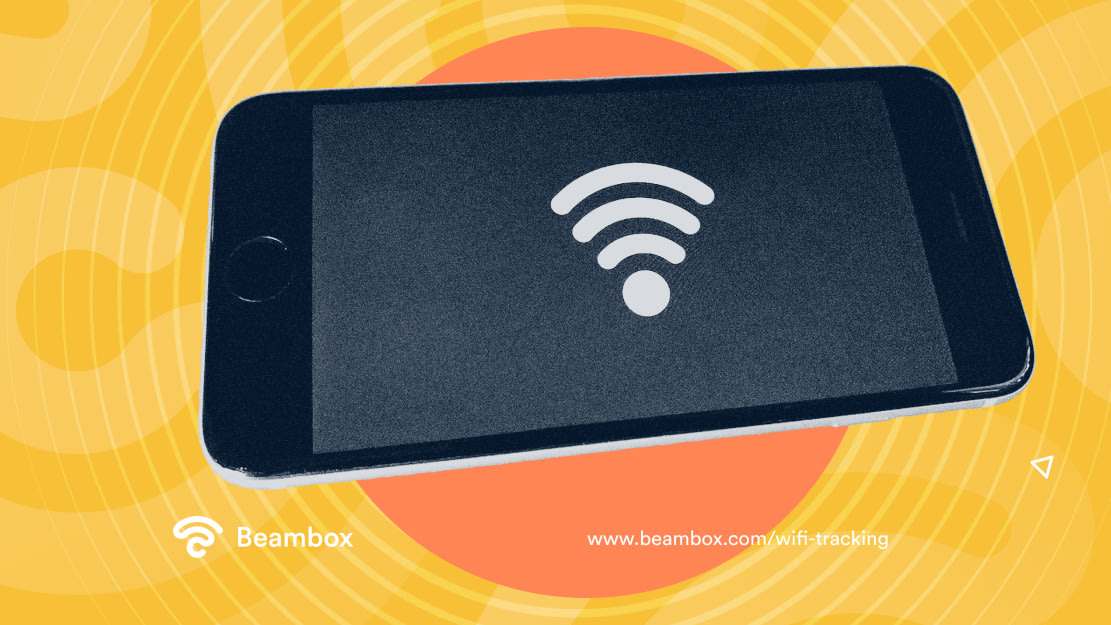WiFi tracking is a fantastic way for businesses to gather customer data and improve their marketing strategies. However, even if this data collection offers many benefits for businesses, it must be done with awareness and the right tools.
In this article, you will learn the ins and outs of WiFi tracking, including the legal considerations businesses must consider when using this technology. You will also discover how to use WiFi tracking to improve your marketing results.
What Is WiFi Tracking and How Does It Work?

WiFi tracking is not a technology in and of itself. It is a set of tools and approaches that businesses can use to collect data from customers’ devices as they connect to their internet network. This technology works by tracking devices’ Media Access Control (MAC) addresses. These unique identifiers allow businesses to recognize when a device connects to a network. Once a device has connected, businesses can use WiFi tracking to collect a wide range of data.
Businesses can then use this data to gain insights into customer behavior and preferences to improve operations. Furthermore, data can inform and enhance the results of any marketing strategy.
What Types of Businesses Must Take Advantage of WiFi Tracking?
While businesses of all types and sizes can benefit from WiFi tracking, some industries may find it particularly useful:
- Retail stores
- Restaurants
- Hotels
- Shopping malls
- Casinos
- Airports
- Coffee shops
Generally speaking, all businesses can collect data about their users’ internet usage. However, data collection does not necessarily need to be covert.
For example, a restaurant might collect emails through its captive portal to email marketing campaigns.
In short, through data collection, businesses can gain insights into improving their operations and stop guessing.
The Benefits and Drawback of WiFi Tracking for Marketing Purposes.

While WiFi tracking can provide businesses with valuable insights into customer behavior and preferences. It is important to consider this technology’s benefits and drawbacks.
The main benefit of WiFi tracking for your marketing result is gaining insights into customer behavior and preferences. This can help you create effective marketing campaigns and enhance the customer experience. However, there are also potential drawbacks to consider. One concern is the potential for invasion of privacy.
Some customers may feel uncomfortable with a business collecting data through WiFi. This is why you must ensure that collection happens ethically and complies with relevant regulations.
Despite these potential drawbacks, the benefits of tracking for marketing purposes are significant, and you should take advantage of it.
Can WiFi Track Websites Visited? Yes, But…
Can the WiFi track websites visited? Well, it can.
When a user connects to a guest WiFi network of a business, it is possible to monitor its online activity. However, sometimes a user might conceal his behavior online, and it might be hard to track.
For example, with the growing awareness of the risks posed by public WiFi, more people are using VPNs to protect their data and privacy. When a user is using a VPN, it might be extremely hard for a common person to track a user’s online behavior. However, some marketing platforms can still collect data and generalize the behavior of users connected to a specific network.
Can Incognito Be Tracked by WIFI? Here Is the Truth
When it comes to WiFi tracking, there are many misconceptions. Another common question is, “Can incognito be tracked by WiFi?”. Unfortunately, the answer is no.
When a user enters private browsing mode, the browser does not store data such as cookies or browsing history. However, this mode does not prevent other parties, including WiFi tracking tools, from collecting data. The device will still communicate with the network; thus, the software can collect data.
If you care about being private, the simplest solution is to use a VPN. However, it can create some friction while navigating websites. Instead, if you seek maximum privacy, the best option is to use Tor and browse with a compatible browser.
WiFi Tracking Data: What Data Should Businesses Collect?
When collecting data through WiFi tracking, businesses have access to a wealth of information. Ultimately, the data types businesses have to collect will depend on their specific goals. However, here are the most common:
- Location data - WiFi tracking can give businesses insights into where customers spend time within their physical location.
- Browsing history - By tracking the websites that customers visit while on their network, businesses can gain insights into their interests and preferences.
- Demographic information - This data type is extremely important because it can help businesses identify customers and preferences. Then, they can use data to create clusters of users and identify multiple customers profile.
- Frequency of visits - By tracking how often customers visit their location, businesses can gain insights into customer loyalty and engagement.
However, notice that collecting data and analyzing data are two different things. Likewise, analyzing data and implementing strategic actions are different steps in the process of improving your results. Let’s talk about all this.
Analyzing WiFi tracking data involves several key steps that you can take to gain insights into customer behavior and preferences. However, just like collection, it is important to consider your goals even when interpreting data.
You have first to identify patterns and trends. You want to determine which products or services are popular, which are the most visited areas of the venue, and more. If you further segment the data by factors such as age, gender, or other psychographic marketing traits, you can identify specific customer groups. This data will be the basis of specific marketing campaigns.
Another useful practice is to check how data changes over time. By comparing data over a useful timeframe, businesses can identify what is working and what is not. Then, they can adapt to the emerging trends.
2 Ways Businesses Can Use WiFi Tracking Data To Improve Their Marketing Strategies.
Once you have collected and analyzed your WiFi tracking data, there are several ways you can use them. You might apply your new understanding to create a more resonating message. Or else, you can create better advertising or a more apt location for your typical customers.
Generally speaking, there are two main areas where businesses can use the data collected:
- Customer Experience
- Marketing initiatives
Let’s explore both of them.
WiFi Tracking Usecase #1: Improve the Overall Customer Experience
By leveraging the insights gained, you can better understand your customers and enhance the customer experience in various ways.
For example, a retail store might use WiFi tracking data to understand which products are popular and which store areas are most frequently visited. This information can help to optimize the layout and create a more enjoyable shopping experience for customers.
In addition to optimizing operations, WiFi tracking data can help personalize the customer experience. For example, a hotel might use WiFi to gain insights into guest preferences and offer personalized recommendations or services.
Ultimately, you can improve your business at its core with a data-driven approach. This will enhance customer loyalty, drive repeat business, and increase revenue.
WiFi Tracking Usecase #2: Engage With Your Customers With Marketing Initiatives

By leveraging the insights gained from WiFi tracking data, you can create marketing campaigns more likely to resonate with your customers.
For example, a cafè owner might use the new insights to develop better social media ideas for the coffee shop. This will allow the owner to create better messaging and get more interactions.
Similarly, a restaurant might use tracking data to get more reviews. Certain WiFi marketing software allows businesses to send prompts when a user spends time connected to the internet. By tracking the time spent while connected, the owner can optimize the prompt and send it when it is more likely to receive a review.
The point is that data collected through WiFi can improve any marketing strategy. Therefore, the mistake is not collecting data at all.
Legal Considerations of WiFi Tracking: Don’t Skip This
If reading this article makes you consider implementing WiFi tracking in your business, then read this.
From a legal perspective, you must ensure that your tracking complies with the laws and regulations of your jurisdiction. For example, in Europe, businesses must comply with the GDPR. In most cases, you must be transparent about how you intend to use the data. Provide customers with clear information about what data you collect and how you store them.
Be sure to create informative and comprehensive WiFi terms and conditions for your users. Make them evident in your captive portal and prevent access to the internet without accepting them.
WiFi Tracker Devices and Tracking With WiFi Are Not the Same
These two terms often get confused, so it is better to clarify their differences.
A WiFi tracker device is a tool that allows users to view and analyze the wireless networks in their area. They provide information about available WiFi networks, signal strength, and other details to assess the state of the networks in their area.
Professionals use these trackers to troubleshoot network issues or optimize WiFi connections. These tools can also be useful to assess congestion and interference in a particular WiFi frequency range. WiFi tracking, instead, is the set of tools and mechanisms that allow users to track internet use by users. While a tracker device can provide particular information about internet usage, it adds no value for general tracking purposes.
WiFi Location Tracking
WiFi location tracking is a specific type of data collection that aims to track a user’s location or behavior in a specific area. For example, large airports utilize WiFi location tracking to optimize queue management at security checkpoints and boarding gates.
However, even small businesses can take advantage of it. With this type of tracking, businesses can gain a deeper understanding of customer traffic patterns, dwell times, and movement within their physical locations. It can also help adjust staffing levels to ensure enough service during busy periods and avoid overstaffing during slower times.
This type of WiFi tracking can also enable businesses to deliver personalized marketing messages or offers based on a customer’s real-time location within their premises. For instance, a retailer in a mall can send tailored promotions to customers walking nearby the shop.
The Future of WiFi Tracking and Its Potential Impact on the Marketing Industry.
WiFi tracking and social WiFi hotspot have already significantly impacted the marketing industry, but their potential for the future is even more promising. For example, with machine learning and artificial intelligence advancements, businesses can deliver hyper-personalized marketing experiences and messages.
WiFi tracking can also merge with other tracking technologies, such as QR codes or NFC tags, to bridge the gap between online and offline attribution. What is also foreseeable is the integration of WiFi with IoT devices, resulting in contextualized experiences. However, with all these improvements, privacy and security will become more relevant. Regulations and laws will likely become stricter.
How To Get Started With WiFi Tracking
As you have read so far, data collection and analysis can help you optimize your business operations and improve the effectiveness of your marketing initiatives.
The best tools to get started with WiFi tracking are WiFi marketing software like Beambox. With it, you can:
- Collect valuable customer data, including contact information, demographic details, and behavioral insights
- Automate your marketing initiatives, including email campaigns, social media promotions, and personalized offers
- Improve your online reputation and boost your ratings on popular review sites
- Secure your network from common cyberattacks and ensure the safety of your customers’ data
Don’t wait any longer to unlock the full potential of your in-store WiFi! Try Beambox for free for thirty days.
Get Started With Free WiFi Marketing
Beambox helps businesses like yours grow with data capture, marketing automation and reputation management.
Sign up for 30 days free